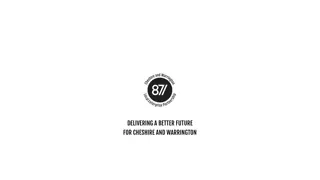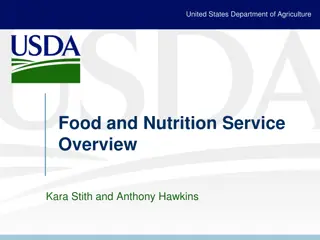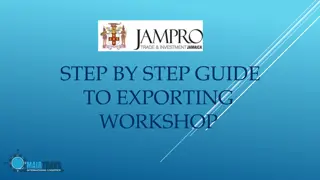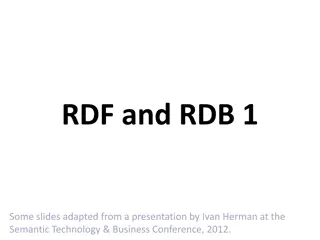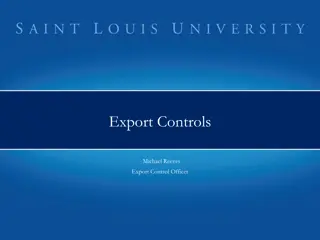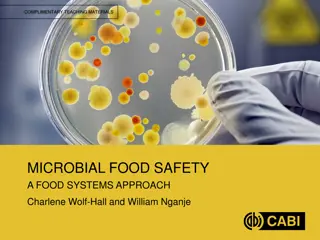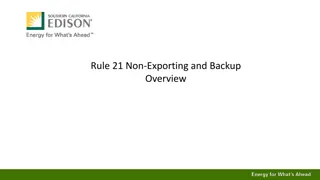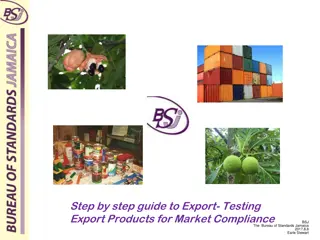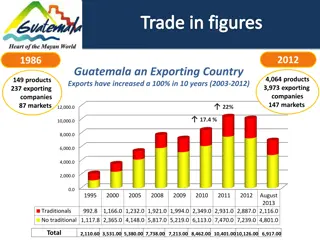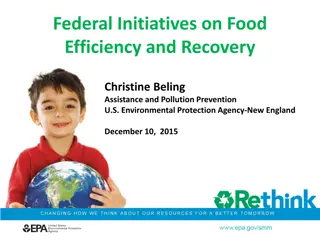Exporting Food Products to the United States: Guidelines and Regulations
The presentation covers essential information for exporting food products to the United States, emphasizing legal requirements, FDA regulations, necessary steps, and facility registration. It details aspects such as safety standards, labeling, customer specifications, and the involvement of various federal agencies in the regulatory process. Understanding these guidelines is crucial for successful and compliant exports to the U.S.
Download Presentation

Please find below an Image/Link to download the presentation.
The content on the website is provided AS IS for your information and personal use only. It may not be sold, licensed, or shared on other websites without obtaining consent from the author.If you encounter any issues during the download, it is possible that the publisher has removed the file from their server.
You are allowed to download the files provided on this website for personal or commercial use, subject to the condition that they are used lawfully. All files are the property of their respective owners.
The content on the website is provided AS IS for your information and personal use only. It may not be sold, licensed, or shared on other websites without obtaining consent from the author.
E N D
Presentation Transcript
Exporting Food Products to the United States Dr. Gleyn Bledsoe Gleyn@Live.com This presentation was made possible with the support of the American People through the U.S. Agency for International Development (USAID). The contents of this document are the sole responsibility of the authors and do not necessarily reflect the views of USAID or the US Government.
HOW TO EXPORT TO THE US: GENERAL ASPECTS Domestic and imported foods must follow the same legal requirements in the U.S. Exporters must provide food that is safe, be free of microbial contamination, chemicals or filth and manufactured under Current Good Manufacturing Practices Must be labeled in conformity with US regulation Must follow US legal regulations (laws of country of origin do not always apply, except in the case of food from New Zealand and Canada). Customer specifications are important and generally include all federal regulations plus purchasing company s additional requirements. FDA does not certify or previously approve food exporters, their products, labeling or cargos. (Voluntary Qualified Importer Program fee program that speeds up imports) FDA may detain an imported consignment if they suspect it is not in accordance with the requirements of the US
US FOOD REGULATORY SYSTEM Food and Drug Administration Implementation of food safety laws to prevent food safety problems in the US population. FDA regulates all food products with the exception of pork, beef, poultry and processed eggs. (which come under USDA responsibility). U.S. Department of Agriculture APHIS protect against animal diseases and plant pests FAS promote US agricultural products in international market FSIS ensure the safety of meat, poultry and processed eggs Environmental Protection Agency (EPA): Registers all pesticides for sale within the US. Also, establishes tolerances for pesticides in food for humans and animals. * There are 15 federal agencies involved in regulating importation of food products
NECESSARY STEPS TO EXPORT TO THE UNITED STATES Registration of Food Facility Prior Notice for shipments (On line Prior Notice access www.access.fda.gov) Have a Food Safety Modernization Act Compliant Food Safety Plan Ensure that the product is safe, wholesome, well- packaged and properly labeled 4
FACILITY REGISTRATION Each site must be separately registered. If a company has six different facilities where a product is processed, it must register each of these facilities. For foods consumed by humans and animals within the US. Registration is free of cost and must state an agent that resides in the US Registration must be renewed every two years! Who must register? Manufacturers or those who process Packers Storage facility Register on line: http://www.access.fda.gov
Food Safety Modernization Act Risk based program that is based upon earlier HACCP concepts Food Processors are to have a Preventive Control Qualified Individual (PCQI) to develop food safety plan and review processing records. Emphasizes employee training and written records Formalized in company s Food Safety Plan Phased in requirement predicated upon company size (this can be misleading and smaller companies should promptly implement this program if they are to sell to larger companies) Certification Training Courses 6
Food Safety Modernization Act contd Very dependent upon written records Training oriented All employees at a facility must be qualified for their job and their training documented Record must be retrievable within 24 hours of notice from FDA Records need not be in English, but must be translated upon request within a reasonable time. Build upon your existing food safety program 7
Relevant Training Courses Preventive Controls for Human Foods Preventive Controls for Animal Foods Foreign Suppliers Verification Program Sanitary Transportation of Food Seafood HACCP Juice HACCP Principles of Thermal Process Control (LACF/AC FOODS) Produce Safety Sprout Safety (Under development) 8
Food Safety Plan Overview A written Food Safety Plan, specific to the facility, is required to include a hazard analysis When hazards requiring a preventive control are identified, the following are required, as appropriate: Preventive controls Process, food allergen, sanitation, supply-chain and others determined through the hazard analysis process A recall plan Food Defense Plan Implementation procedures E.g., validation studies and monitoring, corrective actions and verification procedures The format is flexible
Main Organizational Sections Background Information 1. Background information - optional 2. Hazard analysis 3. Preventive controls 4. Recall plan 5. Food Defense Plan 6. Implementation procedures Analysis Hazard Preventive Controls Recall Plan Implementation Procedures
LACF / AC Low- Acid Canned Foods LACF : Food with a pH of 4.6 or higher and a water activity (aW) > 0.85 Does not include alcoholic beverages Acidified foods - foods with a normal pH of 4.6 or less (not included in LACF) Primary Objective is to control Clostridium botulinum - a type of bacteria that occurs in food kept in poor conditions. Botulinum toxin (produced by the bacteria) grows in acidic and anaerobic environments, and can cause a fatal paralysis in humans. The LACF program helps to prevent the production of this toxin Training Requirement: Basic Certificate in Principles ofThermal Process Control
REQUIREMENTS FOR LACF/AC FOODS Obtain an additional registry with FDA or FCE (Food Canning Establishment) Submit information (*Process Schedule) as to how the product was processed Submission Identifier" (SID) Apply the process to the foods Keep required records * Process Authority develops a process schedule for every product and individual container size/type FDA Link for LACF http://www.fda.gov/Food/GuidanceRegulation/GuidanceDocumentsRegulatoryInf ormation/AcidifiedLACF/default.htm 12
HACCP FOR SEAFOOD http://www.fda.gov/food/guidancer egulation/haccp/ucm2006764.htm 13
HACCP FOR JUICE http://www.fda.gov/Food/GuidanceReg ulation/GuidanceDocumentsRegulatory Information/Juice/ucm072586.htm 14
DAIRY PRODUCTS Additional Requirements Dairy products must be pasteurized Milk and Cream may be exported with a special permit (FDA form-1993) Dairy produce Grade A may only be exported to the US if the producer has been certified by a state or authorized as a processor that complies with the requirements of the Pasteurized Milk Ordinance (PMO). The list of the authorized processors https://www.accessdata.fda.gov/scripts/ims/mkex/ims/imssl- fr.cfm 15
How to Know if an additive is permitted by the FDA ? Everything Added to Food in the United States (EAFUS) This information is generated from a database maintained by the U.S. Food and Drug Administration (FDA) Center for Food Safety and Applied Nutrition (CFSAN) under an ongoing program known as the Priority-based Assessment of Food Additives (PAFA). PAFA contains administrative, chemical and toxicological information on over 2000 substances directly added to food, including substances regulated by the U.S. Food and Drug Administration (FDA) as direct, "secondary" direct, and color additives, and Generally Recognized As Safe (GRAS) and prior- sanctioned substances 16 http://www.accessdata.fda.gov/scripts/fcn/fcnNavigation.cfm?rpt=eafusListing
Labeling Food Label is a panel found on a package of food which contains a variety of information about the nutritional value of the food item. Information standard on most food labels, serving size, number of calories, grams of fat, included nutrients, list of ingredients Allergen notice Other relevant information i.e. Refrigerate after opening 17
General Requirements Label in English Multi-lingual is accepted if all the information is in both languages New requirements as of 2018 Ingredients approved by the FDA and declared with the common name and in descending order based on its weight. FDA Food Labeling Guide: http://www.fda.gov/Food/GuidanceRegulation/GuidanceDocuments RegulatoryInformation/LabelingNutrition/.htm 18
ALLERGENS Responsible for 60% of product recalls in the USA Nuts Milk Seafood and Shellfish Eggs Wheat Fish Soybean Peanuts 20
Two options to declare allergens Within the list of ingredients Common name Followed by the name in parentheses of allergen source Eg.: Ingredients: ... whey (milk) In a separate summary In a separate summary Immediately following list of ingredients in a size not smaller than the ingredients Contains: milk 21
Summary Domestic and imported foods must follow the same legal requirements in the U.S. Exporters must provide food that is safe Packaging/Containers must be labeled in conformity to US regulation FDA does not certify or previously approve food exporters, their products, labeling or cargos. (Voluntary Qualified Importer Program fee program that speeds up imports) FDA may detain an imported consignment if it is not in accordance with the requirements of the US FSMA import compliance places responsibility on importers who in turn rely heavily upon 3rd Party Auditors Training and appropriate records are critical . 22
Summary Become FSMA qualified with a good comprehensive Food Safety Plan Use this in your marketing efforts Be knowledgeable of the FSVP requirements of your customer/importer and provide the data they need Be pro-active!! 23
For any inquiries or assistance: Address: Immeuble Solaris, Rue du Lac d Annecy, Les berges du Lac1053, Tunis. Tel : (+216) 71 86 23 87 Fax : (+216) 71 86 23 78 Mail : brcp-tunisia@pragmacorp.com Website : www.brcp.tn 24





